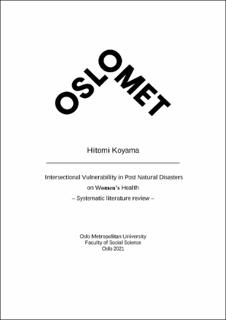| dc.description.abstract | Natural disasters have been growing due to climate change, degradation of the environment, and globalisation. However, there is also a pattern of gender difference in vulnerability to and impact of natural disasters at all levels of the disaster process. Women’s health status is, thus, violated in natural disasters. The purpose of this review study is to investigate how the effects of natural disasters on women’s health are related to social categories, focusing on the intersection of conditions that creates vulnerabilities, and how the studies can help us understand women’s vulnerability to natural disasters. As an approach to understanding vulnerability and situating the post-disaster experiences of women concerning health, the review study referred to the framework of Road map to hell by Wisner. This review study was a systematic review of English-language articles, having studied women’s reproductive health and mental disorder after natural disasters, published in the last 15 years. The data stemmed from a systematic search of journal articles in the general computer databases.
Most studies in this review showed that females were more vulnerable to their health-wise post-natural disasters than males. In addition to gender, socio-economic status such as age, education, economic consequences, and pregnancy or having a child status and living environment made women more vulnerable when exposed to a natural disaster. Furthermore, my review study found that black women in the US and Haitian women with a history of traumatic events were more vulnerable to their health after natural disasters than other women.
Through my review study, we can understand that it does not mean that natural disasters cause significant damage directly and have an impact in the medium to long term. However, the more important we should understand is that the impacts of natural disasters are intersectional vulnerabilities of individuals’ physical and psychological changes and changes in the environment. In addition, my review study showed that the difficulties in accessing multiple public and private resources, such as economic- and health facility resources and kinship networks, made it difficult to cope with post-disaster changes. Therefore, we can draw from my review study that it is imperative to understand and prioritise intersectional vulnerabilities in natural disasters. Furthermore, disaster countermeasures need to consider individual situations such as the type of disaster, living environment, damage situation, one’s life status and degree of social connection, and it is necessary to take measures to improve such vulnerabilities. | en_US |
